These Are the Components of a Truly Comprehensive Employee Wellness Program
Last Updated Nov 13, 2025

Key Takeaways
- A comprehensive wellness program supports the whole employee with interconnected physical, mental, social, and financial resources. It creates an environment where people can access flexible tools that fit real needs and daily routines, which helps them feel supported and ready to perform.
- Wellness programs improve employee health by removing barriers that make healthy habits difficult to maintain. Employees gain access to fitness options, sleep support, mental health care, and nutrition guidance that encourage steady progress and measurable gains across every area of wellbeing.
- Technology elevates wellness programs by personalizing experiences and making care easier to engage with. Digital platforms, wearables, virtual services, and AI-driven recommendations help employees stay consistent while giving HR teams helpful data to refine their strategy.
- Measuring participation, outcomes, and business impact helps leaders understand the true value of wellness investments. Tracking trends, gathering feedback, and documenting success stories allow organizations to show ROI clearly and make informed decisions about where to improve or expand.
- A strong wellness strategy succeeds when it aligns with business goals, reflects employee needs, and evolves over time. Clear objectives, thoughtful communication, cross-functional support, and ongoing evaluations keep programs relevant and effective as the workforce grows and changes.
Picture Sarah, a talented software engineer weighing two job offers.
Both positions offer similar salaries, but one company provides a comprehensive wellness program. For Sarah, workplace wellbeing is just as important as salary — a sentiment shared by 88% of employees, as revealed in Wellhub’s State of Work-Life Wellness 2025 report .
The choice is clear for Sarah: she's going with the company that looks out for her wellbeing.
That’s why many organizations recognize that true wellbeing involves every aspect of an employee’s life, from physical health to financial wellbeing. If you’re looking to compete for top talent and keep your best performers happy, then investing in an employee wellness program could be the way to go.
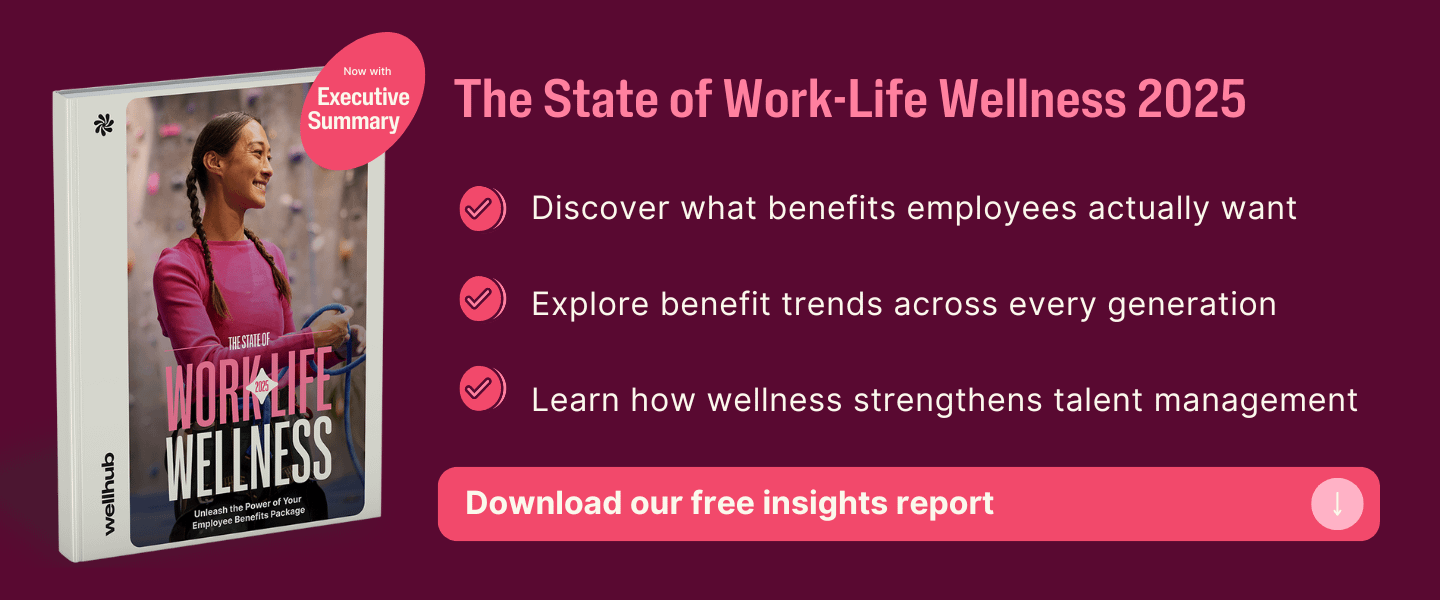
What Is a Comprehensive Wellness Program?
A comprehensive wellness program is a holistic approach to employee health and wellbeing that addresses multiple dimensions of wellness to create a thriving workplace. It supports the whole employee. That means looking beyond fitness to address mental, emotional, financial, and social wellbeing. These programs are built to flex with your people’s needs, not force them into a one-size-fits-all mold.
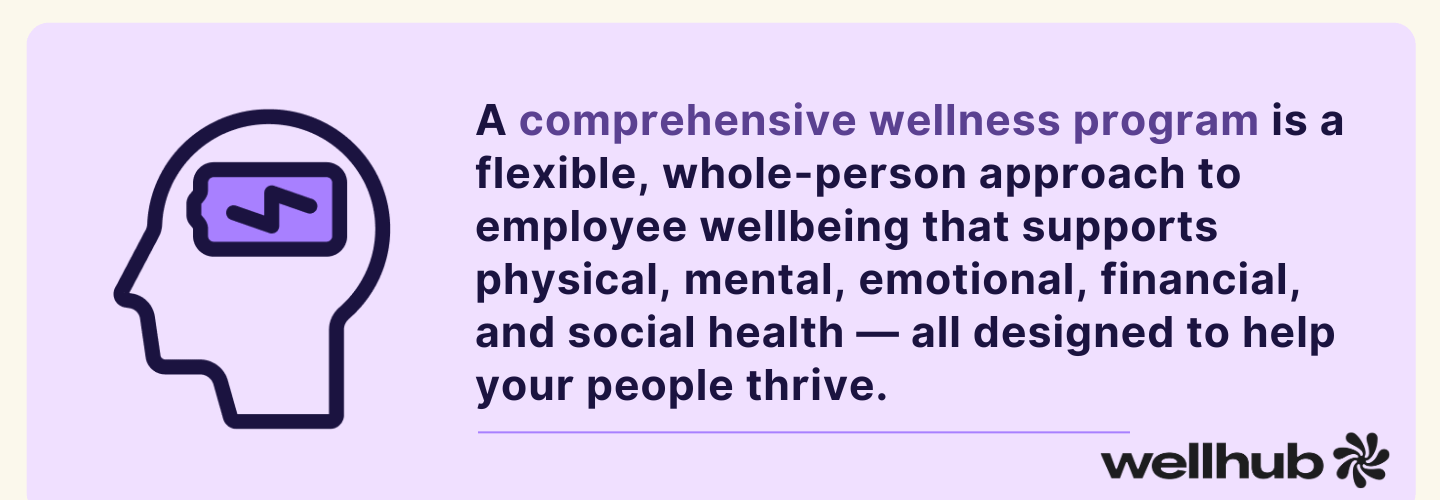
Think of it like this: a strong wellness program might include access to gyms and mental health apps, yes — but also flexible work options, financial education, and ways for employees to connect socially. It’s preventative care and life support all in one.
And it works. Organizations that offer wellness programs see real impact. Employees are more engaged, absenteeism goes down, and retention goes up. In fact, Wellhub’s State of Work-Life Wellness 2025 found that 61% of employees with wellness programs say they’re happy at work, compared to just 36% without one.
That’s not just a win for your people — that’s a serious business advantage.
Core Components of a Comprehensive Wellness Program
A truly effective wellness program needs multiple elements working together to support wellbeing. The comprehensive wellness program components play an important role in creating a culture of health and wellness throughout your organization.
Physical Wellness
The foundation of any wellness program starts with supporting employees’ physical health. Employees who are physically active experience greater emotional, psychological, and social wellbeing, according to a study published in the Journal of Modern Medicine. This translates to improved mood and readiness to tackle their work. Here’s what to consider:
- Health education workshops: Host regular sessions on topics like nutrition, exercise basics, and preventative health care. Consider offering both live sessions and recorded options to maximize accessibility.
- Fitness challengeprograms: Organize fun, engaging competitions that inspire employees and build team spirit.
- Wellness technology: You can use wearable devices or fitness apps to track progress, keeping program participants motivated and connected.
- Workplace ergonomics: Provide ergonomic assessments and equipment recommendations to prevent workplace injuries and promote comfort throughout the workday.
- Preventative screening: Partner with healthcare providers to offer convenient health screenings and biometric assessments, making it easier for employees to stay on top of their health.
- Sleep hygienesupport: Help employees improve their sleep quality through education, tracking tools, and relaxation resources.
Mental and Emotional Wellness
Supporting mental wellness is extremely important for employee wellbeing and organizational success. With 15% of adults suffering from some form of mental illness, according to the World Health Organization, offering mental wellness support is non-negotiable for committed organizations. You can do this by offering:
- Stress management resources: Provide access to meditation apps, relaxation techniques, and professional counseling services to help employees manage stress effectively.
- Flexible work arrangements: Over 90% of workers would benefit from a flexible workplace arrangement, according to a Deloitte study. You can support work-life wellness by offering flexible schedules, remote work options, or compressed workweeks whenever possible.
- Mental health training: Equip managers and employees with the knowledge to recognize mental health challenges and respond appropriately.
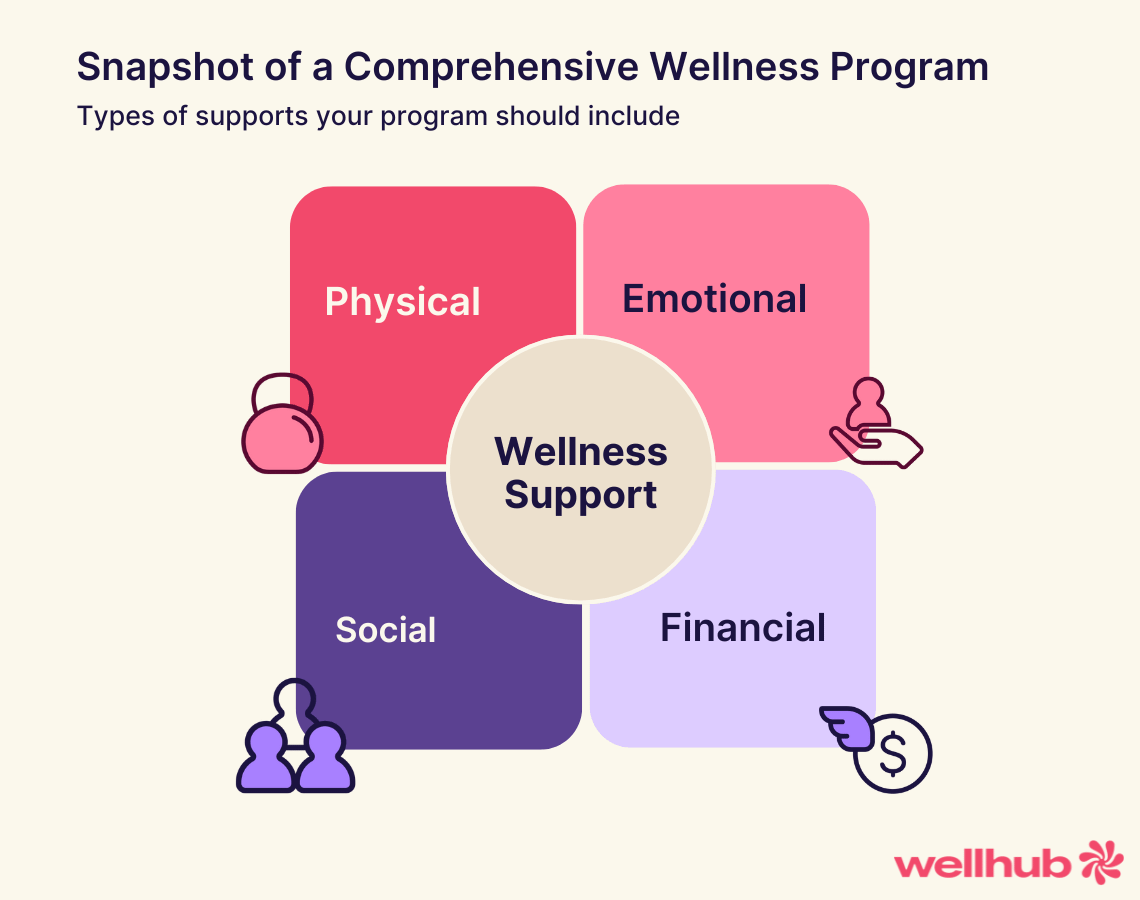
Social Wellness
Building strong social connections at work plays a major role in employee satisfaction and engagement. In fact, employees at companies with a strong workplace culture are more engaged and productive than those without, according to the International Journal of Environmental Research and Public Health. Investing in social wellness initiatives can help create a culture of belonging and collaboration that drives performance. Here’s how:
- Team-building activities: While they may sound cliché, team-building efforts can increase productivity by nearly 40%, according to an EastPharma study. Try incorporating collaborative games, problem-solving exercises, or offsite retreats to strengthen team bonds.
- Regular social events: Host inclusive events like lunches, game nights, or volunteer days to build camaraderie across departments and levels of seniority.
- Employee Resource Groups (ERGs): Create safe spaces for underrepresented groups to connect and find support. ERGs foster inclusion while giving employees a stronger sense of purpose and community.
Financial Wellness
Nearly one in four employees say that their financial stress impacted their productivity at work, according to a SoFi survey. That’s why it’s so important to offer comprehensive support to help employees build financial security and confidence. Here’s how:
- Educational workshops: Offer sessions on important topics like budgeting, debt management, and investment strategies. Make sure the content is relevant to employees at different stages of life and career.
- Digital tools and resources: Provide access to budgeting apps and calculators that help employees track spending, set goals, and make informed decisions.
- Retirement planning support: Create opportunities for employees to learn how to optimize their retirement benefits through one-on-one consultations and group seminars.
- Employee assistance programs: Consider setting up an emergency fund for employees in need. Sometimes, life happens, and your organization can be a valuable ally during tough times.
How Comprehensive Wellness Programs Improve Employee Health
When you invest in a comprehensive wellness program, the payoff is big.
From sleep quality to fitness, from mental health to nutrition, employees with access to robust wellness support consistently report better health outcomes across the board.
Let’s take a look at how these programs drive real, measurable impact on employee health.
Physical Wellness Gets a Boost
Wellness programs help remove common barriers to exercise and healthy routines — like cost, time, and lack of access. Employees with wellness programs are more than twice as likely to report good fitness levels (63%) compared to employees without wellness support (33%). Nearly half of Wellhub users (48%) report working out daily, compared to just 31% of those without the program.
And those habits pay off: 73% of Wellhub users say their physical wellbeing improved over the last year, compared to just 41% of non-users.
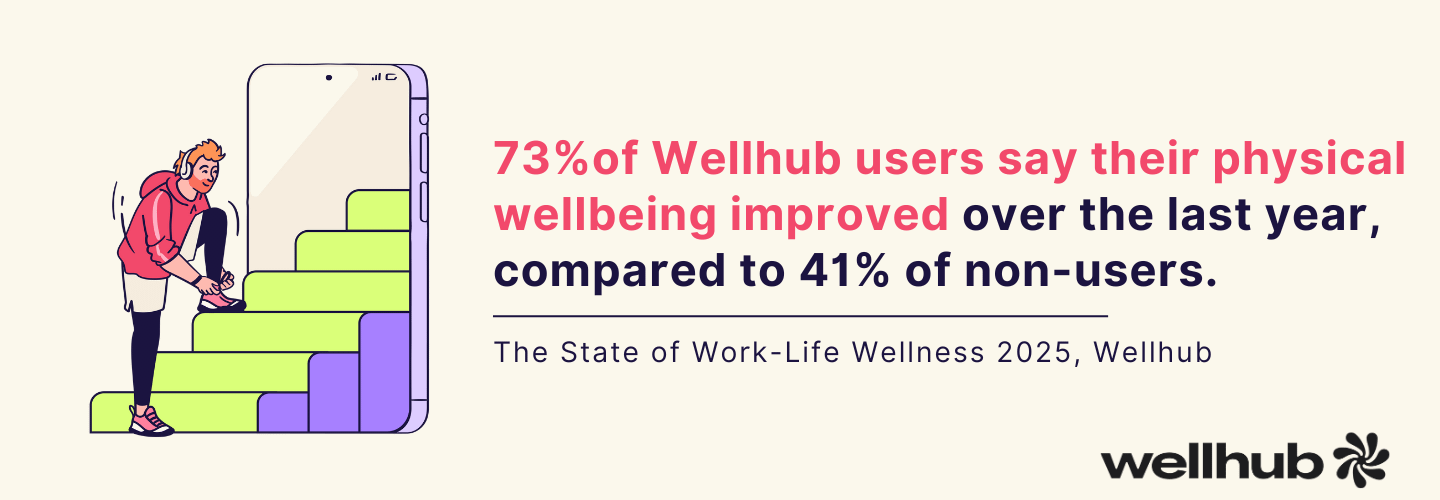
Better Sleep, More Energy
Sleep is one of the most overlooked elements of employee health — and one of the most affected by stress. Only 32% of employees report having healthy sleep patterns. However, employees with wellness programs are nearly twice as likely to achieve quality sleep compared to those without (39% vs. 21%).
This is critical when you consider that 53% of workers lose sleep due to stress and anxiety, and more than half (55%) say mental health challenges interfere with their sleep.
A comprehensive wellness program can help employees unwind through mindfulness apps, sleep coaching, and flexible work policies that give them time to rest.
Mental Wellness Improves with Access
Stress is a top threat to emotional wellbeing — and 47% of employees say that work stress is degrading their mental health.
But the good news? A comprehensive approach to wellness can turn that around. Seventy-one percent of employees with Wellhub report positive mental wellbeing, compared to just 53% of those without access to a wellness program.
Even more encouraging: 75% of employees with Wellhub say their mental wellness improved over the last year, while only 43% of those without the program saw similar progress.
This kind of improvement comes from layering accessible, stigma-free support — like digital therapy, mindfulness tools, and education — directly into daily work life.
Healthier Eating and Nutrition Habits
When wellness programs include nutrition support, employees are more likely to eat well — and that influences every area of health. Forty-seven percent of workers with a wellness program report having a good diet, compared to just 29% without.
Programs that offer guidance, access to nutritionists, or food-tracking tools can reduce barriers like cost (cited by 35% of employees) and time constraints (32%) — the two biggest reasons employees say they don’t eat better.
These resources help employees make healthier choices that fuel productivity and prevent long-term health issues.
Wellness Programs Build Momentum Across All Areas of Health
Here’s where it all comes together: employees who have access to comprehensive wellness benefits report stronger overall health across multiple domains. For example:
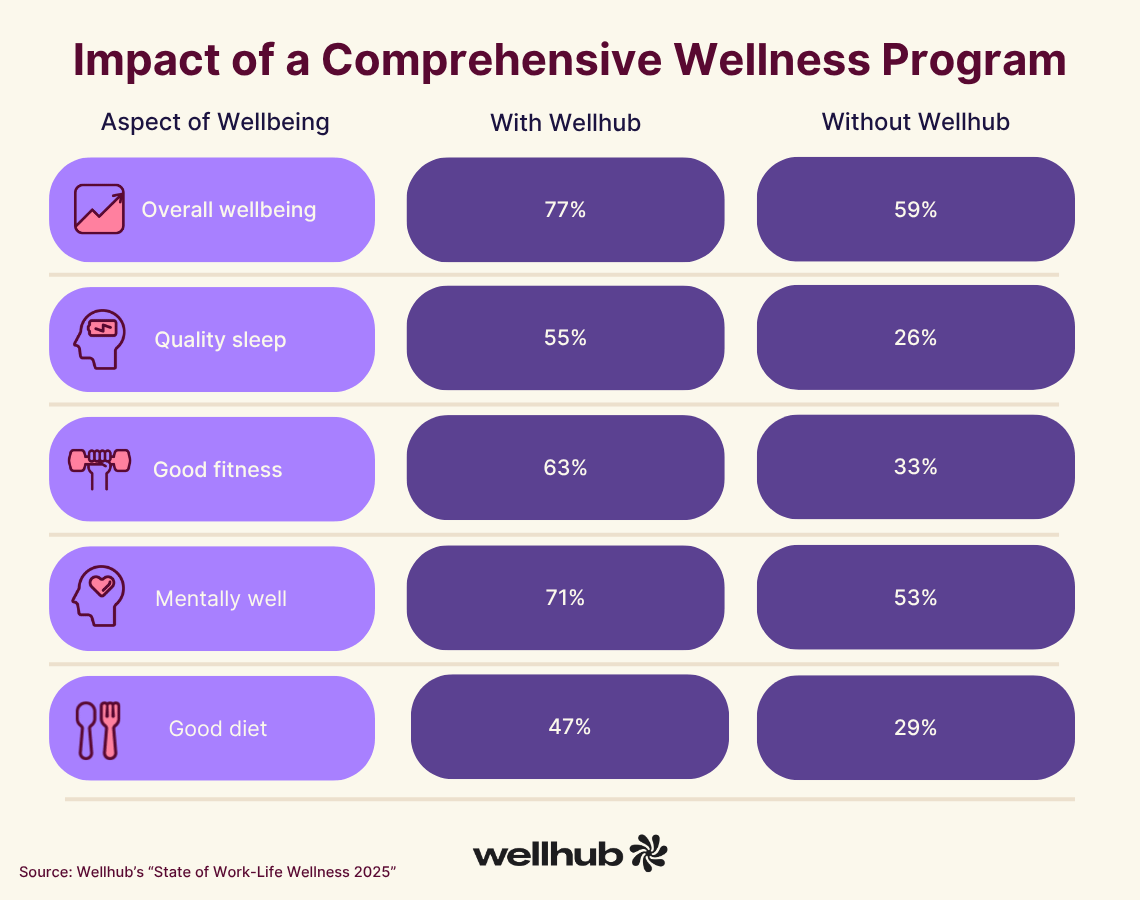
These numbers show the power of a connected approach to health. When employees are supported with tools that address the full picture — from the food on their plate to their financial confidence — they’re more likely to thrive.
Integrating Tech Into Comprehensive Wellness Programs
Technology has made health resources more accessible and engaging than ever before. Modern wellness technology creates personalized experiences that adapt to each employee’s unique needs and preferences while providing valuable data that help HR departments optimize their wellness strategies.
A tech-integrated wellness program removes many traditional barriers to participation and helps create a culture of continuous wellness improvement. Here are some of the best practices for integrating technology into your wellness initiatives.
Wellness Platforms and Apps
Digital wellness platforms can be the central hub of your program, bringing together various resources and tools in one convenient location. These platforms completely change how employees engage with wellness initiatives by providing personalized experiences and seamless access to health resources.
Here’s what to keep in mind:
- Mobile accessibility: Choose platforms with mobile apps that let employees engage with wellness programs anytime, anywhere. Look for intuitive interfaces that make navigation and participation effortless.
- Integration capabilities: Pick a solution that can connect with your existing HR systems and third-party apps, creating a unified experience for both employees and administrators.
- Social features: Prioritize platforms that include social components like team challenges, progress sharing, and peer support networks to boost engagement and accountability.
- Content customization: Aim for platforms that can deliver personalized content and recommendations based on individual wellness goals, health risks, and interests. This can help employees make more meaningful progress with the time and effort they dedicate to their wellness.
Wearable Devices and Health Tracking
Wearables like fitness trackers and smartwatches are powerful tools in a wellness strategy. They provide:
- Real-time health data
- Daily motivation for healthier habits
- A tangible link between activity and wellness goals
By showing progress in real time, wearables help employees visualize their success — making improvement feel doable and rewarding.
When searching for a vendor, look for one that:
- Follow strict data security standards
- Offer robust privacy protections
- Have a strong track record of confidentiality
And before launching their wearables to your workforce, build trust by:
- Clearly outlining what data is collected and why
- Explaining how data will (and won’t) be used
- Offering opt-in or anonymized participation where possible
Telehealth and Virtual Wellness Services
Virtual care has expanded rapidly — and employees are embracing it. Popular options include:
- Video therapy sessions
- Text-based counseling
- Apps like Headspace for mindfulness and stress relief
Whether your team is fully remote, hybrid, or on-site, virtual wellness services help everyone by:
- Eliminating commute barriers
- Increasing access across locations
- Supporting employees in rural or underserved areas
Offering multiple ways to engage — from phone to app to video — helps normalize mental health support and makes it easier for employees to seek help when they need it most.
AI-Powered Wellness Solutions
Artificial intelligence adapts to each employee’s unique needs by analyzing data in real time. It helps personalize wellness programs in a way that’s scalable, strategic, and proactive.
The result? Smarter, more effective wellness experiences.
The key benefits of integrating AI into your wellness program include:
- Smart Goal Setting: It can help track activity, sleep, and habit or Adjust goals automatically based on progress. For example, if an employee exceeds step goals but struggles with stress, AI shifts the focus to stress-reduction strategies
- Behavioral Insights: AI can identify when and how employees engage and help tailor content and challenges by work style. Remote workers, for example, may prefer digital challenges, while in-office teams engage more with group fitness
- Predictive Risk Assessment: This tech can flag emerging health risks using anonymized behavior trends and tracks signs like increased sedentary time or low program engagement. This empowers HR to offer early interventions before issues escalate.
Measuring Program Success
A data-driven approach to evaluating your wellness programs ensures your investment delivers meaningful results for both employees and the organization. It's where you can identify what’s working and what may need some adjustments.
Key Metrics to Track
Successful programs rely on comprehensive monitoring strategies that include both quantitative and qualitative indicators. While there are countless metrics to track, it’s always a good idea to focus on those that align with your program's objectives, including:
- Participation rates: These keep an eye on overall engagement levels and identify which components of your program are the most popular. Low participation rates can mean a lack of interest or awareness, while high participation rates show that employees are enjoying the program. This insight can help you decide where to allocate your budget.
- Health outcomes: The main goal of a comprehensive wellness program is to improve overall employee health. Track changes in health indicators like hospital visits and sick days to measure the impact of your wellness programs.
- Business impact: Measure shifts in productivity, absenteeism, and healthcare costs to demonstrate the value of your program. This data is particularly valuable for executives.
- Employee feedback: Regularly collect qualitative feedback through surveys and focus groups to better understand the user experience. At the end of the day, you won’t know what employees are thinking unless you ask them!

Analyzing Data and Demonstrating ROI
Converting wellness program data into meaningful return on investment (ROI) metrics helps you justify continued investment in employee wellbeing initiatives. As revealed in Wellhub’s Return on Wellbeing 2024 report , 56% of companies that track the ROI of their wellness initiatives see a return of over 100% on their investments. Here’s how you can track ROI to assess your program’s effectiveness:
- Establish baseline measurements for key metrics like healthcare costs, absenteeism rates, and employee satisfaction before launching your program.
- Track changes in these metrics every quarter, keeping in mind any seasonal patterns or external factors that could impact results.
- Create monthly or quarterly reports on participation rates, health outcomes, and cost savings.
- Compare your results against industry benchmarks to provide context for stakeholders.
- Document success stories and employee testimonials to complement your quantitative data.
- Use your findings to optimize program elements and reallocate resources effectively.
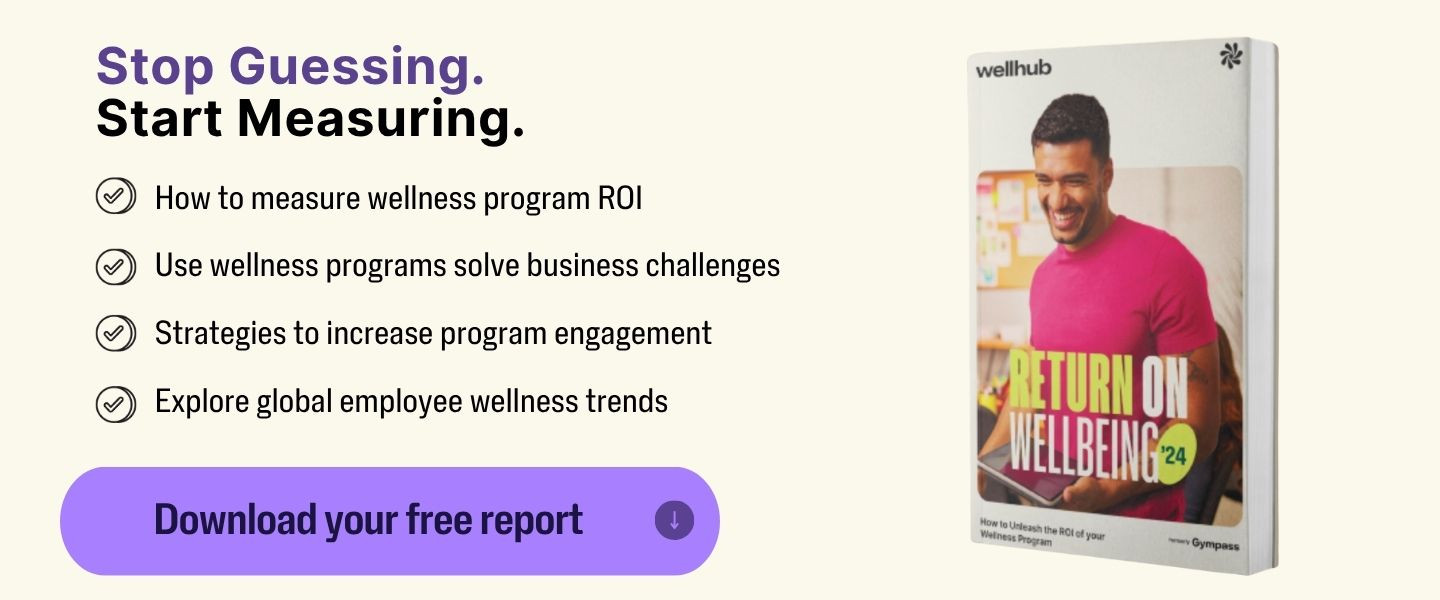
Using Data to Refine and Improve Your Program
The most successful wellness programs evolve through continuous feedback and data analysis. Use your program metrics to identify areas for improvement and make data-driven decisions about future investments. You could even create a wellness committee that regularly reviews program data and recommends updates based on emerging trends and employee needs.
How to Select, Launch, and Assess the Success of a Comprehensive Wellness Program (Step by Step)
Step 1: Align with Business Goals
A wellness program aligned with business objectives is easier to get buy-in for and delivers more measurable ROI. For example, if lowering healthcare costs is a top priority, focus on preventative care tools and fitness engagement. If talent acquisition is the goal, emphasize flexibility, mental health, and inclusivity. Your strategy should match your company’s trajectory.
Before launching any initiative, make sure your wellness program supports your company’s broader strategy. Are you focused on reducing turnover? Enhancing productivity? Expanding your workforce? Identify these priorities upfront.
Step 2: Understand Employee Needs and Preferences
The most successful wellness programs are shaped by employee input. Tailoring offerings to your population’s real needs boosts both engagement and impact. Survey your team to learn what wellness support they value most, and what barriers are standing in their way. Ask about their interest in fitness, mental health, nutrition, financial education, and sleep support.
Step 3: Define Clear, Measurable Goals
Goals make it easier to track progress, demonstrate value, and make improvements. They also help secure executive buy-in, as leadership is more likely to support programs with clear business outcomes.
Use the SMART goals framework to set goals that are Specific, Measurable, Achievable, Relevant, and Time-bound. Goals might include increasing employee participation in fitness programs by 25% in six months or reducing stress-related absences by 10% in a year.
Step 4: Build a Cross-Functional Wellness Team
A wellness committee creates accountability and broadens your program’s visibility. Plus, it ensures diverse voices are influencing the program — a key factor in creating inclusive and accessible offerings.
Recruit champions from HR, leadership, facilities, and even employee volunteers to guide the strategy and rollout of your wellness program.
Step 5: Choose the Right Technology and Partners
Select a wellness platform that offers flexibility, personalization, and integration with your HR systems. If possible, include wearables, telehealth, mental health support, and coaching.
This is critical because convenience is key. Employees are more likely to use programs that fit their daily routines. For example, employees with access to wellness programs are nearly twice as likely to achieve quality sleep compared to those without. The right tech stack can make or break your participation rates.
Step 6: Create a Communication and Launch Plan
Communication drives engagement. Without it, even the best wellness program will go underutilized.
Design an internal campaign to roll out the program. Include kickoff events, benefit guides, and ongoing email or Slack updates. Keep messaging positive, clear, and inclusive. Use storytelling to highlight success stories and leadership endorsements to build excitement.
Step 7: Launch with Purpose
First impressions count. A strong launch signals your commitment to wellbeing and helps normalize participation right away.
Introduce the program in a way that feels energizing and inclusive. Host a launch event, offer early access perks, and make sure employees know where and how to get started.

Step 8: Track Participation and Health Outcomes
Monitor enrollment, usage, satisfaction, and wellness metrics such as fitness levels, stress, and absenteeism. Pair this with qualitative feedback through regular employee surveys.
This helps because you can’t improve what you don’t measure. This data reveals what’s working — and what’s not. For example, if participation in mental wellness support is low, that may signal stigma or access issues you can solve.
Step 9: Evaluate ROI and Business Impact
HR leaders often struggle to connect wellbeing with bottom-line impact. ROI metrics help justify continued (and expanded) investment, especially when presenting to the C-suite. Fortunately, according to Wellhub’s Return on Wellbeing 2024report, 56% of companies that track wellness ROI see returns over 100%.
You can track your returns by watching how productivity, turnover, healthcare costs, and absenteeism are impacted by the introduction of a wellness program.
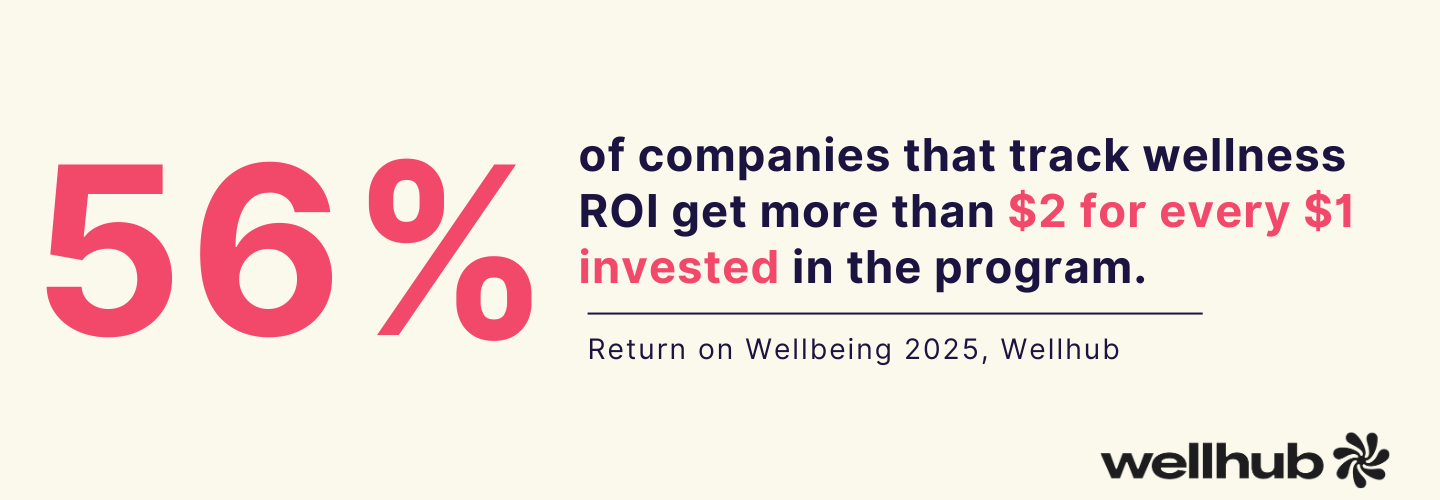
Step 10: Continuously Improve
Wellness isn’t static. Employee needs change, and your program has to adapt over time. Companies that refine their strategy based on real-time feedback and performance metrics see higher engagement and retention.
Set quarterly or biannual reviews to revisit your goals, reassess employee needs, and evolve your offerings. Consider emerging wellness trends and demographic shifts when refining your program.
Improve Your Wellness Strategy With Expert Support
Creating a comprehensive wellness program involves more than just adding a few perks. It requires strategic planning, incorporating technology, and a commitment to continuous optimization. Each element plays a critical role in supporting your workforce’s overall wellbeing and driving organizational success.
With Wellhub, these challenges become opportunities. Our platform offers a vast network of fitness centers, wellness apps, and personalized wellbeing solutions that integrate seamlessly into your company’s strategy. Wellhub is proven to more than double employee engagement with wellness initiatives, reduce turnover by up to 40%, and save companies up to 35% on healthcare costs.
Speak with a Wellhub Wellbeing Specialist to see how we can help you take your wellness programs to the next level.

Company healthcare costs drop by up to 35% with Wellhub*
See how we can help you reduce your healthcare spending.
[*] Based on proprietary research comparing healthcare costs of active Wellhub users to non-users.
Related:
- A Generational Guide to What Workers Want — and How to Deliver
- 11 Corporate Wellness Trends Shaping 2025
- How Wellness Programs Increase Employee Productivity
References:
- American Psychological Association. (2023). 2023 work in America survey. Apa.org; American Psychological Association. https://www.apa.org/pubs/reports/work-in-america/2023-workplace-health-well-being
- Baharom, G. K., Stoverink, T. G., & Kalogiannidis, O. S. (2022). Effect of Team Building on Employee Productivity; A Case Study of Eastpharma Company in Turkey. Journal of Human Resource &Leadership, 6(4), 11–20. https://doi.org/10.53819/81018102t50109
- Deloitte. (n.d.). Workplace Flexibility Survey. Deloitte United States. https://www2.deloitte.com/us/en/pages/about-deloitte/articles/workplace-flexibility-survey.htm
- Marenus, M. W., Marzec, M., & Chen, W. (2022). Association of Workplace Culture of Health and Employee Emotional Wellbeing. International Journal of Environmental Research and Public Health, 19(19), 12318. https://doi.org/10.3390/ijerph191912318
- SoFi. (2024). The Future of Workplace Financial Wellbeing. SoFi. https://www2.sofiatwork.com/2024FutureofWorkplaceFinancialWellbeing
- Szarek, S., Edyta Bombiak, & Aneta Wysokińska. (2024). The Role of Physical Activity in the Improvement of Well-being - the Case of University Staff. Journal of Modern Science, 56(2), 263–284. https://doi.org/10.13166/jms/188741
- Wellhub. (2024a). Return on Wellbeing Study 2024. Wellhub. https://wellhub.com/en-us/resources/research/return-on-wellbeing-2024/
- Wellhub. (2024b). State of Work-Life Wellness. Wellhub. https://wellhub.com/en-us/resources/research/work-life-wellness-report-2
- Who. (2024). Mental health in the workplace. World Health Organization. https://www.who.int/teams/mental-health-and-substance-use/promotion-prevention/mental-health-in-the-workplace
Category
Share

The Wellhub Editorial Team empowers HR leaders to support worker wellbeing. Our original research, trend analyses, and helpful how-tos provide the tools they need to improve workforce wellness in today's fast-shifting professional landscape.
Subscribe
Our weekly newsletter is your source of education and inspiration to help you create a corporate wellness program that actually matters.
Subscribe
Our weekly newsletter is your source of education and inspiration to help you create a corporate wellness program that actually matters.
You May Also Like

FSA vs. HSA Strategy for HR Leaders | Wellhub
Compare FSA vs HSA rules, tax advantages, eligibility, and rollover differences to help employees choose the right account and avoid costly compliance issues.

Benefits Strategy Roadmap: Pull and Retain Top Talent | Wellhub
Support wellbeing, reduce turnover, and maximize ROI with a benefits strategy built for today’s workforce—not yesterday’s spreadsheet.

FTO vs. PTO: What’s the Difference? | Wellhub
Strong time-off policies fuel wellbeing and performance. See how flex and paid time off help HR leaders improve retention, productivity, and business results.